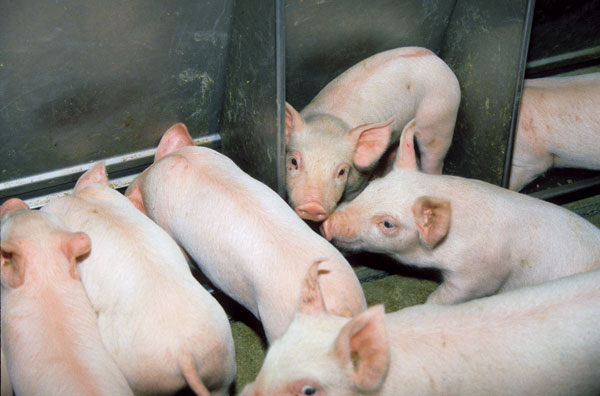It’s not been an easy road for the three-year-old hog operation, which has battled bouts of porcine reproductive and respiratory syndrome (PRRS) and recent staff turnover

At Prairie Ridge Hog Farm at Mantorville, MN, staff take very seriously the critical task of creating healthy pigs that will flourish in this 2,500-sow, farrow-to-finish operation.
It’s not been an easy road for the three-year-old hog operation, which has battled bouts of porcine reproductive and respiratory syndrome (PRRS) and recent staff turnover.
To help turn around the operation owned by Craig Benedix, a soft-spoken crop farmer who also manages the off-site, grow-finish portion of the business, sow farm consultant Steve Hargis was hired several months ago.
Hargis, owner of Strategic Pork Solutions, LLC at Wells, MN, works at the sow farm twice a week to bolster education and training of staff, and to emphasize the importance of proper animal welfare that will support improvements in productivity.
A list of top animal welfare guidelines is prominently displayed on a chalkboard in the farm’s break room. For Hargis, keenly aware of recent events involving the release of an undercover video alleging animal abuse at an Iowa hog farm, zero tolerance is the key element to protecting market access and integrity for the nation’s hog farms.
“From our perspective, we want to make sure that everyone understands the written animal welfare policy that we have on this and other farms and the importance of zero tolerance.
“That means if you violate this policy and do something intentional or premeditated that involves working with animals, then we are going to fire you pretty fast,” Hargis stresses. And, if someone witnesses acts of animal abuse and doesn’t report the violation to the proper staff person, “you are enabling that act so you would be terminated as well,” he adds.
In his view, pork producers have a vested stake in animal care, highlighted by the fact that on most farms, “producers provide better health care, nutrition and housing for pigs than we do for the poor people who live in this country.”
Improving Performance
Farm owner Benedix also contacted consulting swine veterinarian Mike Strobel of the Cannon Valley Veterinary Clinic, Northfield, MN, to help improve farrowing performance. Six months ago, preweaning mortality was running 15-16%, and through changes it has dropped by an average of 4%.
Strobel advised staff to spend more time working on getting daily procedures on track. “You can’t overestimate the value of working with people on farms to follow standard operating procedures correctly, every day, in order to hit that magic number of weaning 1,000 to 1,200 pigs/week to fill finishing barns downstream,” he says. Pigs are weaned at 18 to 21 days of age.
The farm was routinely using ceftiofur hydrochloride (Excenel from Pfizer Animal Health) and 1% tincture of iodine to treat pigs after castration and tail docking, Strobel explains. Instead, he suggested they replace the iodine with his company’s new product, a spray-on formulation called Barrier II Wound Care with Pain Relief (Aurora Pharmaceutical, LLC; www.aurora
pharmaceutical.com), immediately after castration and tail docking.
The spray contains 2% povidone iodine and lidocaine, the latter a known, safe pain reliever used in humans for sunburns and bug bites.
“Barrier II Wound Care is the first topical product on the market that has ever been designed for animals for pain nullification,” Hargis points out. “It is huge when you look at it from an animal welfare perspective, and it is a step in the right direction for our industry in terms of numbing or dulling pain.”
Strobel says industry projections are that 50 to 75% of farrowing operations don’t apply any sort of topical treatment following castration.
The spray-on product should be applied at castration, which is done at Day 3-5 on most farms. When used at Prairie Ridge, it was a factor in reducing deaths by laid-ons from 73% down to 66%, Strobel says.
A single spray provides a sealed barrier to infection that can last up to three days, at a cost of about a penny a dose, Strobel says.
Prairie Ridge owner Benedix and employee Tony Laue agree that they were “pretty skeptical” of the product at first, but say there is a clear difference in the appearance of treated pigs.
Strobel suggests the spray has helped pigs bounce back after castration.
“You can see the difference in the behavior of the pigs immediately after treatment for castration,” Strobel says. “Pigs get up, nurse and get back to more normal behavior faster than untreated piglets.”
The product also works well on docked tails, Strobel says, which he suggests appears to be more painful for the pig than castration. “During tail docking, you are cutting across the very end of the spinal column where there are a lot of nerves. So you see a profound effect when you put something on there that numbs that nerve.”
Hargis says the spray works well to treat shoulder sores that sows sometimes get. The product has the added advantage of water solubility, so it can be removed if a producer decides to send a sow to market.
“Products like Barrier make the farrowing manager’s job easier,” Hargis says. Employees appreciate the fact that they are doing something for the pig that they can feel good about, Strobel notes.
About the Author(s)
You May Also Like





